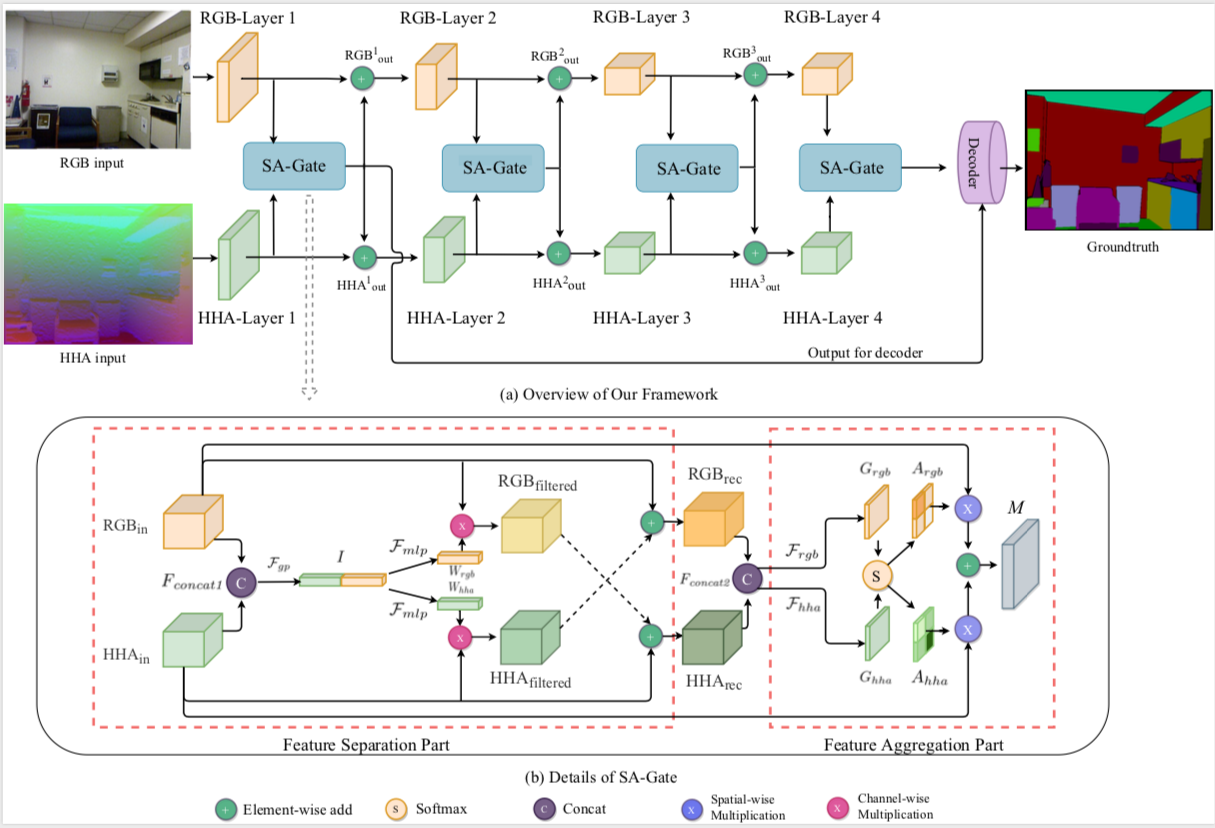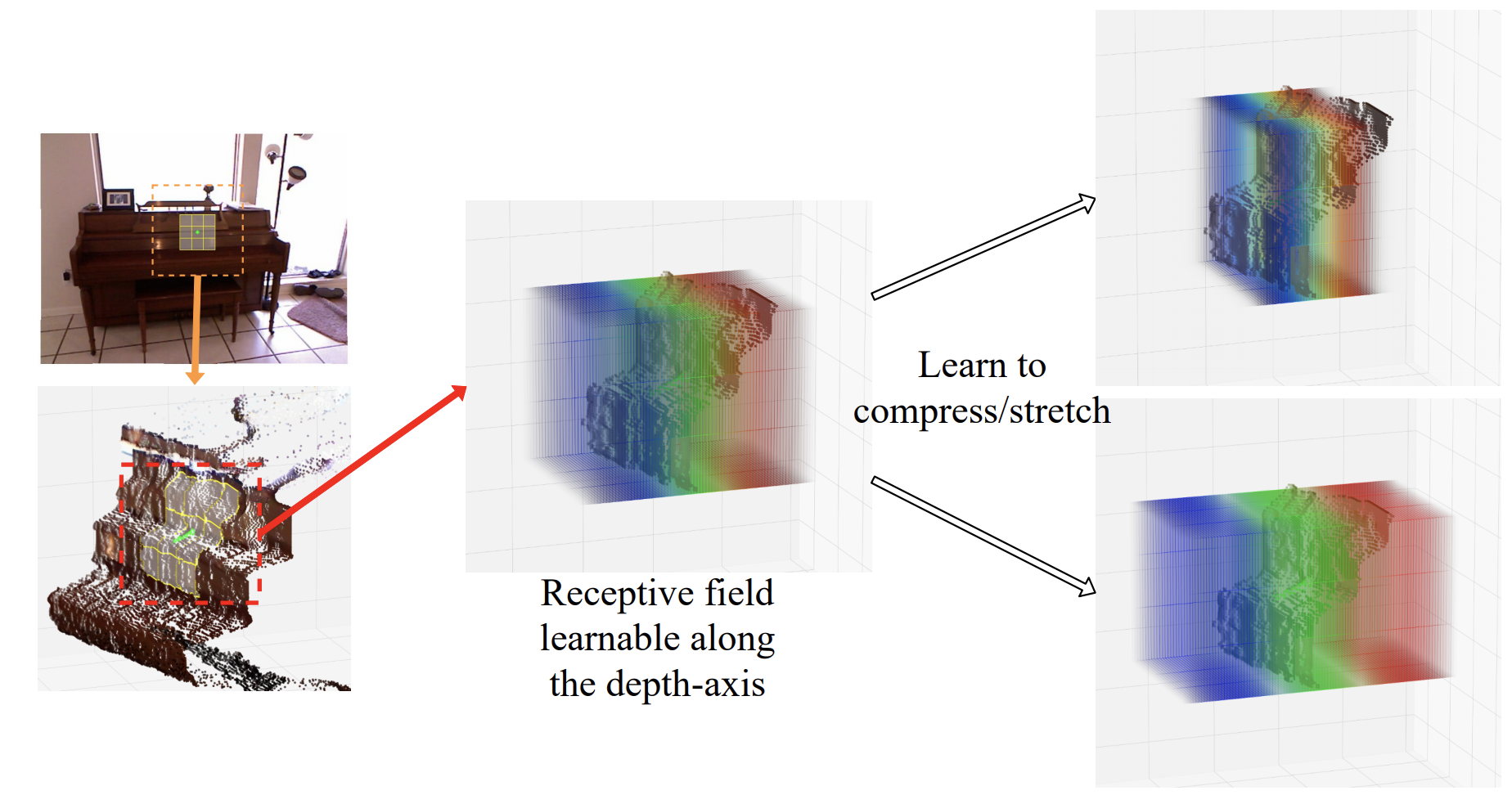Implement some state-of-the-art methods of RGBD Semantic Segmentation task in PyTorch.
Currently, we provide code of:
- 2020/08/16
Official code release for the paper Malleable 2.5D Convolution: Learning Receptive Fields along the Depth-axis for RGB-D Scene Parsing, ECCV 2020. [arXiv], [code]
Thanks aurora95 for his open source code!
- 2020/07/20
Official code release for the paper Bi-directional Cross-Modality Feature Propagation with Separation-and-Aggregation Gate for RGB-D Semantic Segmentation, ECCV 2020. [arXiv], [code]
| Method | mIoU (%) |
|---|---|
| 3DGNN | 43.1 |
| ACNet | 48.3 |
| RDFNet-101 | 49.1 |
| PADNet | 50.2 |
| PAP | 50.4 |
| Malleable 2.5D | 50.9 |
| SA-Gate | 52.4 |
Results on CityScapes Test Set with Multi-scale Inference (out method uses output stride=16 and does not use coarse-labeled data)
| Method | mIoU (%) |
|---|---|
| PADNet | 80.3 |
| DANet | 81.5 |
| GALD | 81.8 |
| ACFNet | 81.8 |
| SA-Gate | 82.8 |
For more details, please refer to our paper.
Your directory tree should look like this:
./
|-- furnace
|-- model
|-- DATA
-- |-- pytorch-weight
-- |-- NYUDepthv2
| |-- ColoredLabel
| |-- Depth
| |-- HHA
| |-- Label
| |-- RGB
| |-- test.txt
| |-- train.txt
The code is developed using Python 3.6 with PyTorch 1.0.0. The code is developed and tested using 4 or 8 NVIDIA TITAN V GPU cards. You can change the input size (image_height and image_width) or batch_size in the config.py according to your available resources.
-
Clone this repo.
$ git clone https://github.com/charlesCXK/RGBD_Semantic_Segmentation_PyTorch.git $ cd RGBD_Semantic_Segmentation_PyTorch -
Install dependencies.
(1) Create a conda environment:
$ conda env create -f rgbd.yaml $ conda activate rgbd
(2) Install apex 0.1(needs CUDA)
$ cd ./furnace/apex $ python setup.py install --cpp_ext --cuda_ext
Please download the pretrained ResNet-101 and then put it into ./DATA/pytorch-weight.
| Source | Link |
|---|---|
| BaiDu Cloud | Link: https://pan.baidu.com/s/1Zc_ed9zdgzHiIkARp2tCcw Password: f3ew |
| Google Drive | https://drive.google.com/drive/folders/1_1HpmoCsshNCMQdXhSNOq8Y-deIDcbKS?usp=sharing |
You could download the official NYU Depth V2 data here. After downloading the official data, you should modify them according to the structure of directories we provide. We also provide the processed data. We will delete the link at any time if the owner of NYU Depth V2 requests.
| Source | Link |
|---|---|
| BaiDu Cloud | Link: https://pan.baidu.com/s/1iU8m20Jv9shG_wEvwpwSOQ Password: 27uj |
| Google Drive | https://drive.google.com/drive/folders/1_1HpmoCsshNCMQdXhSNOq8Y-deIDcbKS?usp=sharing |
If you want to generate HHA maps from Depth maps, please refer to https://github.com/charlesCXK/Depth2HHA-python.
We just take SA-Gate as an example. You could run other models in a similar way.
Training on NYU Depth V2:
$ cd ./model/SA-Gate.nyu
$ export NGPUS=8
$ python -m torch.distributed.launch --nproc_per_node=$NGPUS train.pyIf you only have 4 GPU cards, you could:
$ cd ./model/SA-Gate.nyu.432
$ export NGPUS=4
$ python -m torch.distributed.launch --nproc_per_node=$NGPUS train.py- Note that the only difference between
SA-Gate.nyu/andSA-Gate.nyu.432/is the training/inference image crop size. - The tensorboard file is saved in
log/tb/directory.
Inference on NYU Depth V2:
$ cd ./model/SA-Gate.nyu
$ python eval.py -e 300-400 -d 0-7 --save_path results- Here, 300-400 means we evaluate on checkpoints whose ID is in [300, 400], such as epoch-300.pth, epoch-310.pth, etc.
- The segmentation predictions will be saved in
results/andresults_color/, the former stores the original predictions and the latter stores colored version. Performance in mIoU will be written tolog/*.log. You will expect ~51.4% mIoU in SA-Gate.nyu and ~51.5% mIoU in SA-Gate.nyu.432. (single scale inference with no flip) - For multi-scale and flip inference, please set
C.eval_flip = TrueandC.eval_scale_array = [1, 0.75, 1.25]in theconfig.py. Differenteval_scale_arraymay have different performances.
Please consider citing this project in your publications if it helps your research.
@inproceedings{chen2020-SAGate,
title={Bi-directional Cross-Modality Feature Propagation with Separation-and-Aggregation Gate for RGB-D Semantic Segmentation},
author={Chen, Xiaokang and Lin, Kwan-Yee and Wang, Jingbo and Wu, Wayne and Qian, Chen and Li, Hongsheng and Zeng, Gang},
booktitle={European Conference on Computer Vision (ECCV)},
year={2020}
}@inproceedings{xing2020-melleable,
title={Malleable 2.5D Convolution: Learning Receptive Fields along the Depth-axis for RGB-D Scene Parsing
},
author={Xing, Yajie and Wang, Jingbo and Zeng, Gang},
booktitle={European Conference on Computer Vision (ECCV)},
year={2020}
}Thanks TorchSeg for their excellent project!
- More encoders such as HRNet.
- Code and data for Cityscapes.
- More RGBD Semantic Segmentation models



